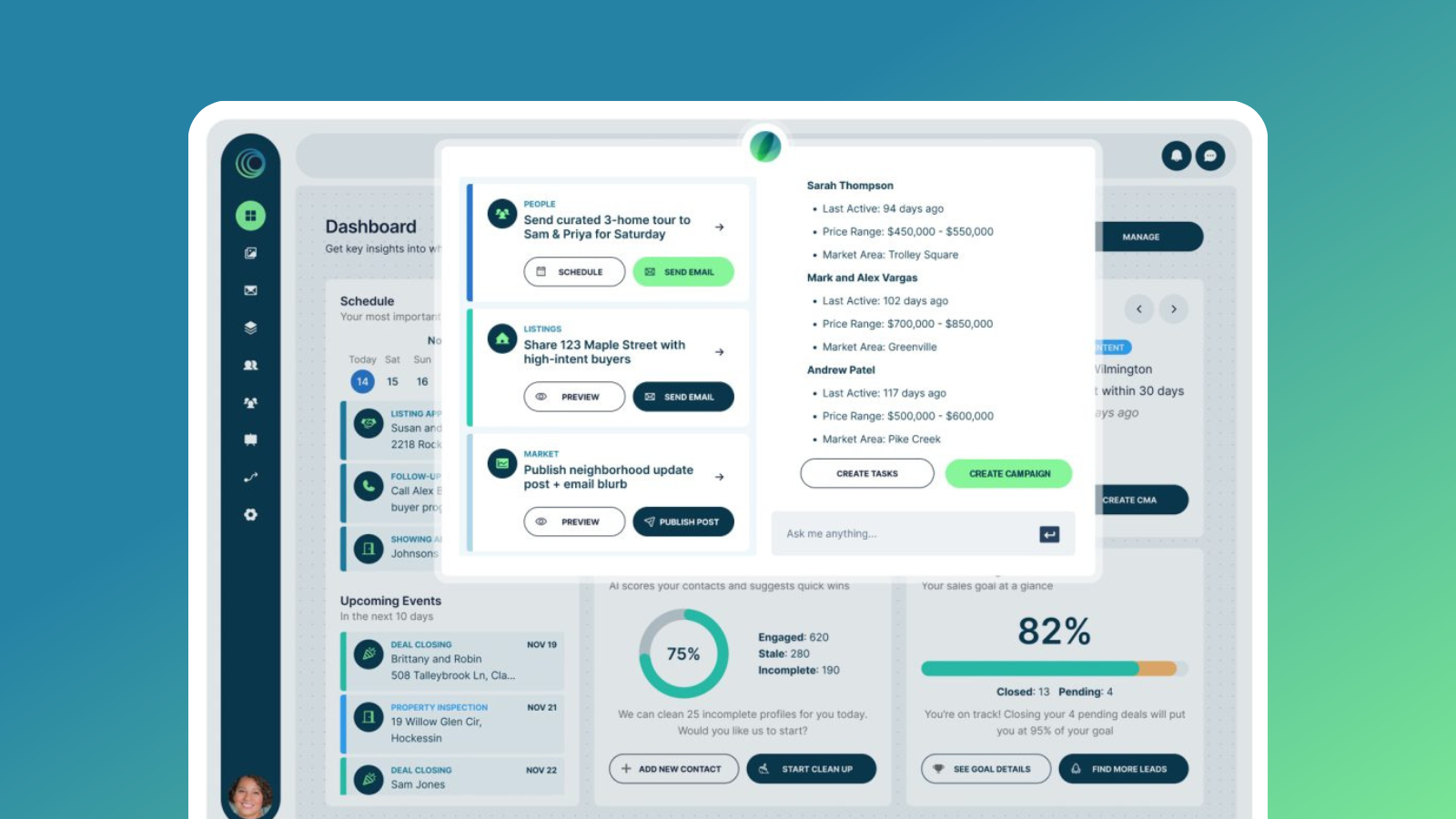Nailing a few key drip email marketing flows is a game-changer for busy agents. Done right, it nurtures leads, builds relationships, and drives conversions—all while you focus on closing deals. But crafting email campaigns that deliver results requires more than just attaching a market report your broker made and hitting “send.” It’s all about strategy.
In this article, we’ll explore:
- Core principles for successful drip email marketing in real estate
- Common types of email drip campaigns
- A detailed breakdown of how to create a winning real estate newsletter
Let’s get started!

8 Principles for Crafting A Winning Email Drip Campaign
1. Know Your Audience
Personalization is king, and it’s about a lot more than starting your emails with “Hi [FIRSTNAME]!” — although addressing them by name is definitely the bare minimum. 76% of online consumers get frustrated when businesses recommend things that have nothing to do with their interests (Source: McKinsey & Company). Don’t let bland, impersonal emails turn your hard-earned leads into unsubscribes.
The key to engaging (instead of annoying) drip email marketing for real estate is making your content as relevant as possible to what your audience wants to see from your brand. Segment clients by buyer, seller, home search phase, neighborhood — anything that will help you narrow in on content they will be uniquely interested in. Create content that addresses specific pain points for them, like “How much is my home worth?”, “Where are the best school districts?”, or “Which areas are the best for a first home?”.
2. Keep It Short and Sweet
People have short attention spans—on average, people spend a mere 9 seconds to scan an email. (Source: Litmus) Use punchy headlines and skimmable content to get your message across quickly and encourage clicks.
3. Deliver Value
Provide actionable insights and tips, and don’t bury them deep in your email. For example, try sharing home repair tips, market trends, or exclusive listings you can help them see today.
4. Timing Matters
Send the emails in your drip campaign at times when people are regularly checking their inbox. The best time differs per audience, but in general, midweek days (T-Th) during working hours are optimal for email engagement. According to CoSchedule, Thursdays at 10 a.m. are the best time to send.
5. Automate — But Stay Human
Automation is powerful, but generic emails fall flat and can even damage your brand loyalty. Infuse every message with your unique personality before you set up any drip campaigns. When in doubt, don’t send it, and definitely don’t set it up to automatically send.
6. Make it Mobile-Friendly
It should come as no surprise that these days, the majority of emails are opened on mobile devices. Always test the emails you include in your drip campaigns to ensure every one of them looks great on small screens.
7. Include Clear CTAs
Too often, email CTAs like “Get started” or “Learn more” leave people wondering what will happen when they click. “Whether it’s “Schedule a Free Consultation” or “View New Listings,” always tell readers their next step so they can click with confidence.
8. Test, Track, and Tweak
Use A/B testing to fine-tune subject lines, email copy, and designs. Then, monitor key metrics like open rates, click-through rates, and conversions. Any decent email service provider should be able to provide you with basic email engagement for every send, and full-featured marketing platforms with drip email campaigns for real estate can often pair these metrics with your website’s analytics to show you which email version(s) drove the most activity downstream
![]() Pro Tip: No time to mess around with designing emails, setting up drip campaigns, or A/B testing? ActivePipe’s ready-to-use email campaigns are battle-tested by agents and consistently outperform the competition. Experience 100% personalized, 100% automated email you can trust to set, forget, and drive business. Explore ActivePipe.
Pro Tip: No time to mess around with designing emails, setting up drip campaigns, or A/B testing? ActivePipe’s ready-to-use email campaigns are battle-tested by agents and consistently outperform the competition. Experience 100% personalized, 100% automated email you can trust to set, forget, and drive business. Explore ActivePipe.

What to Send: Types of Real Estate Drip Campaigns
Okay, so now you’ve got the download creating impactful email content for drip campaigns. But what kinds of drip email campaigns for real estate are actually worth building out versus sending one-off? Here’s a breakdown of the drip email campaigns agents swear by:
Welcome Series
Introduce your brand and set the stage for a lasting connection. A welcome series is particularly important to forge a relationship with internet leads, who may only know you as the person who answered the phone when they clicked “Contact Agent”. Include a personal story, market insights, and a “how we can help you” breakdown. Be sure to keep it brief and leave enough space in between email sends to avoid giving readers the feeling of being bombarded.
Lead Nurturing
A low percentage of leads are jumping to actively buy or sell a house on day one. Until they’re ready, convert your hesitant buyers or sellers with tailored emails addressing key objections or concerns.
Newsletter Campaigns
The right time to transact will pass you by if you don’t stay in the loop. Keep leads and clients in the know with regular updates on market trends, tips, and local events. We’ll go deeper into the anatomy of a great newsletter below!
Homebuyer Education Series
Buying a home for the first time can be a daunting process, with tons of terminology and steps people are learning about for the first time. Help new buyers get up to speed by providing neighborhood highlights, plenty of listings in their target, and step-by-step guides from pre-approval to closing.
Seller Education Series
Teach sellers how to prep their home for sale in order to get the most value from their investment, educate them on your recommended marketing process, and share data that helps them understand local market dynamics.
Event-Based Drips
As a real estate agent, it’s important that your audience views you as highly tapped into the local community. Promote open houses, local events, or even seasonal local deals with timely reminders.
Post-Closing Follow-Up
Stay in touch after the deal to reinforce your relationship over time. Share home maintenance tips, connections to pros, and seasonal ideas for enjoying their home. Don’t be shy about asking for referrals and reviews!

Deep Dive: A Winning Real Estate Newsletter
Newsletters are a cornerstone of drip email marketing in real estate. They keep you top of mind while delivering value-packed content. Let’s break down the elements of a really good one.
1. Start with a Strong Subject Line
Your subject line determines whether your email gets opened or ignored. Aim for intrigue and relevance. Reveal the gist of your email, without giving away too many details or making it unreadably long. Example: “Your [Month] Market Update: Prices Are Rising Fast!”
2. Add Value with the Right Content
Every newsletter should have three main elements:
- Market Updates: Share recent trends like average home prices or days on market. Include visuals like graphs for extra impact.
- Tips & Tricks: Offer value, like home improvement ideas or tax-saving strategies for homeowners.
- Community Insights: Spotlight local events, businesses, or attractions to build goodwill.
3. Keep It Visual
Use high-quality images and short, engaging text. Canva and other tools make it easy to create visually appealing newsletters.
4. Include Links and CTAs
Drive engagement with clickable links. For example: “Check out our new listings here” or “Schedule a consultation with me today.”
5. Make Sure You Show Up
Don’t make your audience double-check the sender to figure out who this newsletter is from. Feature your contact information and headshot prominently in your intro or footer to remind them who curated the content they are enjoying, and convey a sense of warm professionalism.
6. Be Consistent
Send your newsletter monthly, without fail. Consistency builds trust, and trust leads to loyalty.
Don’t worry — you’ve got this
Drip email marketing in real estate can transform your business, and while it can seem time-consuming and complicated to get set up, it doesn’t have to be. From newsletters to lead nurturing campaigns, it’s all about delivering value, staying consistent, and building trust over time. Start with these principles and campaign ideas, and you’ll see results.



